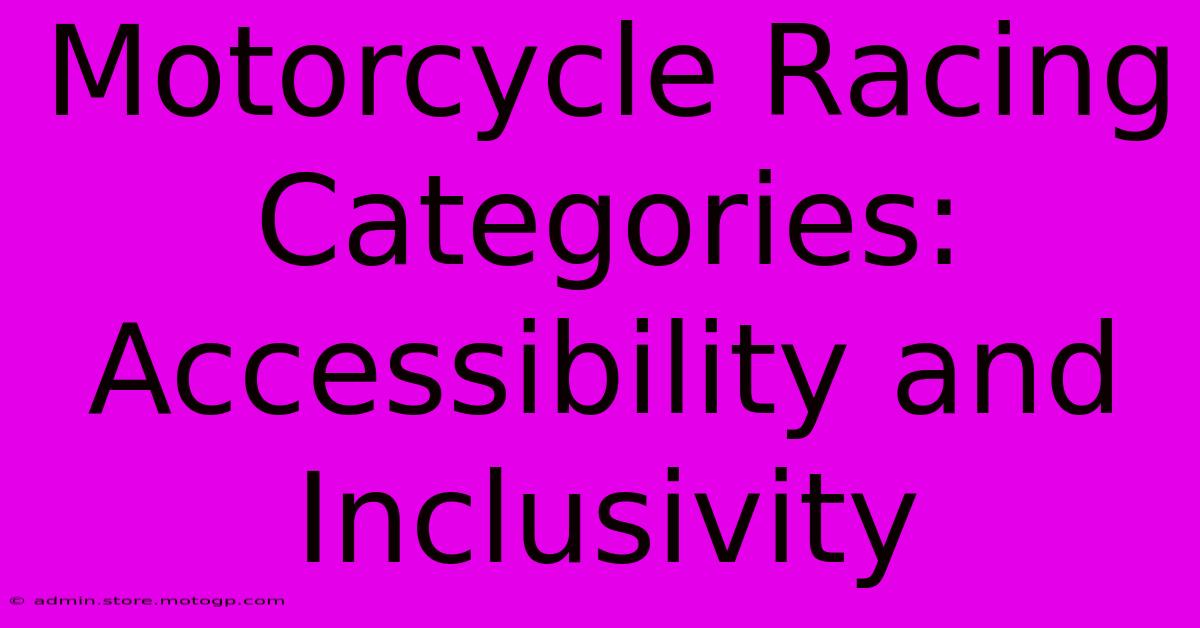Motorcycle Racing Categories: Accessibility And Inclusivity

Table of Contents
Motorcycle Racing Categories: Accessibility and Inclusivity
Motorcycle racing, a thrilling spectacle of speed and skill, is often perceived as an exclusive sport. However, a growing movement champions accessibility and inclusivity, aiming to broaden participation and representation across various categories. This article delves into the existing categories, explores efforts towards greater inclusivity, and discusses potential future developments in making motorcycle racing a truly diverse and welcoming sport.
Existing Motorcycle Racing Categories: A Diverse Landscape
Motorcycle racing boasts a diverse range of categories, each with its own set of rules, machinery, and skill sets. These categories cater to different levels of experience and physical capabilities, although significant room for improvement remains in terms of comprehensive inclusivity.
Road Racing:
- MotoGP: The pinnacle of motorcycle road racing, featuring the fastest and most technologically advanced machines. This category, while incredibly competitive, currently lacks robust pathways for riders with disabilities.
- World Superbike (WSBK): Similar to MotoGP but with slightly less powerful bikes and regulations that, theoretically, could be adapted to accommodate certain types of disabilities. However, currently, adaptations are not widely implemented.
- Supersport: A step down from WSBK, often seen as a feeder series for higher classes. Again, accessibility is limited.
- MotoAmerica, British Superbike, etc.: Numerous national and regional road racing championships exist, offering varied levels of competition and potential avenues for increased accessibility.
Off-Road Racing:
- Motocross: This demanding discipline requires exceptional physical strength and agility. While modifications might be possible for certain disabilities, they aren't currently standardized or widely adopted.
- Enduro: Similar physical demands to motocross but with a focus on endurance and navigation. Again, adaptations are limited.
- Rally: This category often involves teams, potentially creating more opportunities for diverse participation through support roles.
Challenges to Accessibility and Inclusivity
Several significant hurdles prevent wider accessibility in motorcycle racing:
- Physical Demands: The sport inherently requires significant physical strength, stamina, and agility. Adapting regulations and machinery for riders with disabilities presents a complex engineering and safety challenge.
- Cost: Motorcycle racing is expensive, requiring significant investment in equipment, training, and travel. This creates a barrier for many, regardless of physical ability.
- Lack of Adapted Equipment and Infrastructure: There’s a significant lack of purpose-built motorcycles and racing infrastructure designed for riders with disabilities.
- Limited Awareness and Support: Increased awareness and support from governing bodies, sponsors, and teams are crucial to fostering inclusivity.
Efforts Towards Greater Inclusivity
While significant progress is needed, there are positive developments:
- Adaptive Sports Programs: Emerging adaptive sports programs are beginning to explore motorcycle racing adaptations, focusing on modifications to bikes and safety protocols. These are vital early steps.
- Technological Advancements: Technological advancements in assistive devices and prosthetic technology could potentially overcome some physical limitations.
- Advocacy Groups: Advocacy groups are actively working to promote inclusivity within motorsport. Their voice is crucial in pushing for change within governing bodies.
Future Directions for a More Inclusive Sport
To truly embrace inclusivity, the motorcycle racing world needs to proactively implement these changes:
- Development of Adaptive Racing Classes: Creating dedicated racing classes for riders with disabilities, using adapted motorcycles and safety measures tailored to their specific needs.
- Investment in Research and Development: Further research and development are crucial to design safe and effective adaptive equipment.
- Collaboration and Partnerships: Collaboration between governing bodies, engineers, disability organizations, and riders is essential.
- Accessibility Standards: Implementing accessibility standards in race tracks and facilities to ensure inclusivity for spectators and participants.
- Media Representation: Increased media coverage of adaptive motorcycle racing is vital to raise awareness and inspire participation.
Conclusion:
Motorcycle racing has the potential to be a truly inclusive sport. By addressing the challenges, fostering collaboration, and investing in innovative solutions, the motorsport community can create a more welcoming and diverse environment for all. The future of motorcycle racing hinges on its commitment to accessibility and inclusivity, ensuring that passion and skill, not physical limitations, determine who can participate and excel.

Thank you for visiting our website wich cover about Motorcycle Racing Categories: Accessibility And Inclusivity. We hope the information provided has been useful to you. Feel free to contact us if you have any questions or need further assistance. See you next time and dont miss to bookmark.
Featured Posts
-
Yamaha Moto Gp The Untold Story Team News And Insights
Feb 20, 2025
-
Race Bikes For Sale Feel The Need For Speed
Feb 20, 2025
-
Moto Gp Live Free Stream All Races Live
Feb 20, 2025
-
F1 Parking Pre Book And Avoid Disappointment
Feb 20, 2025
-
Moto Gp Top Speed Engineering At Its Finest
Feb 20, 2025
